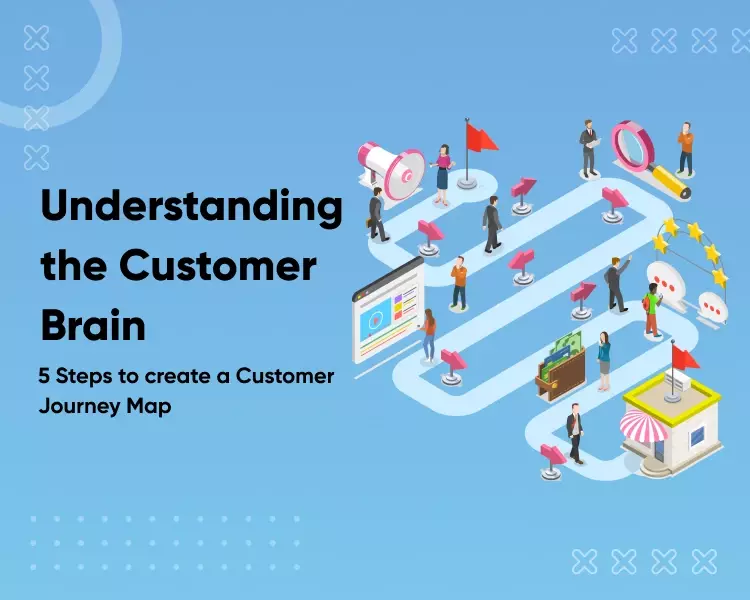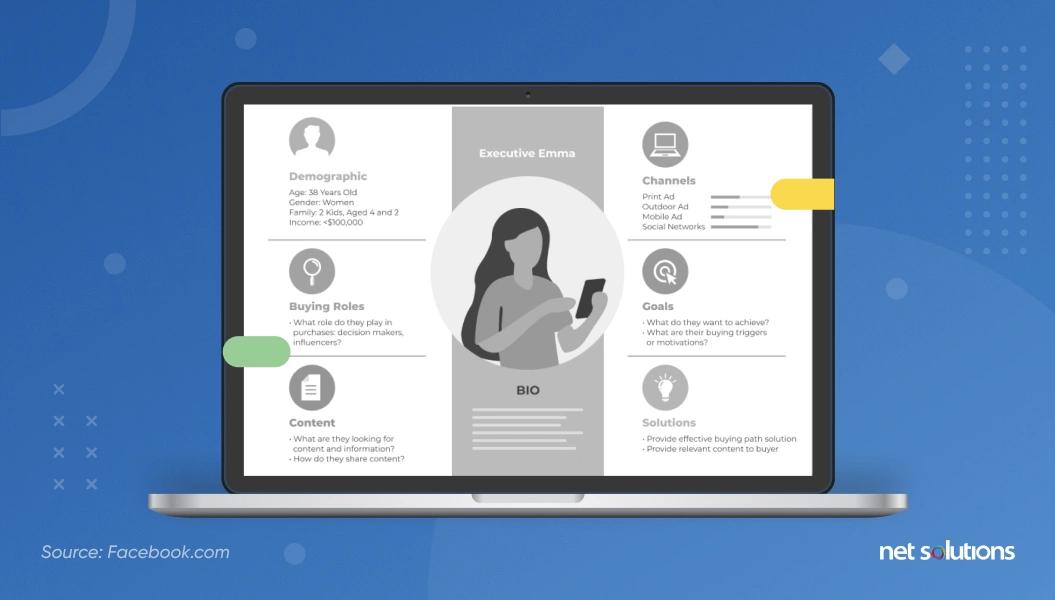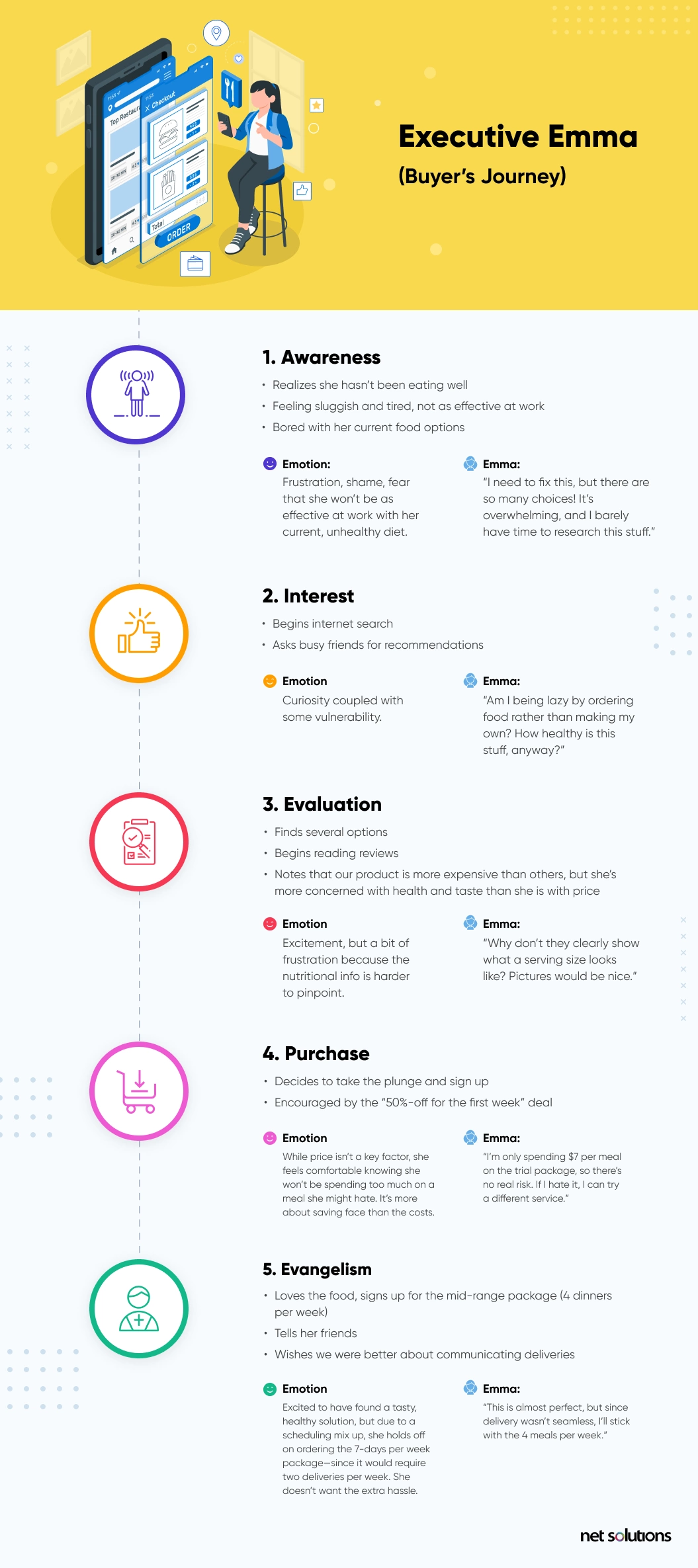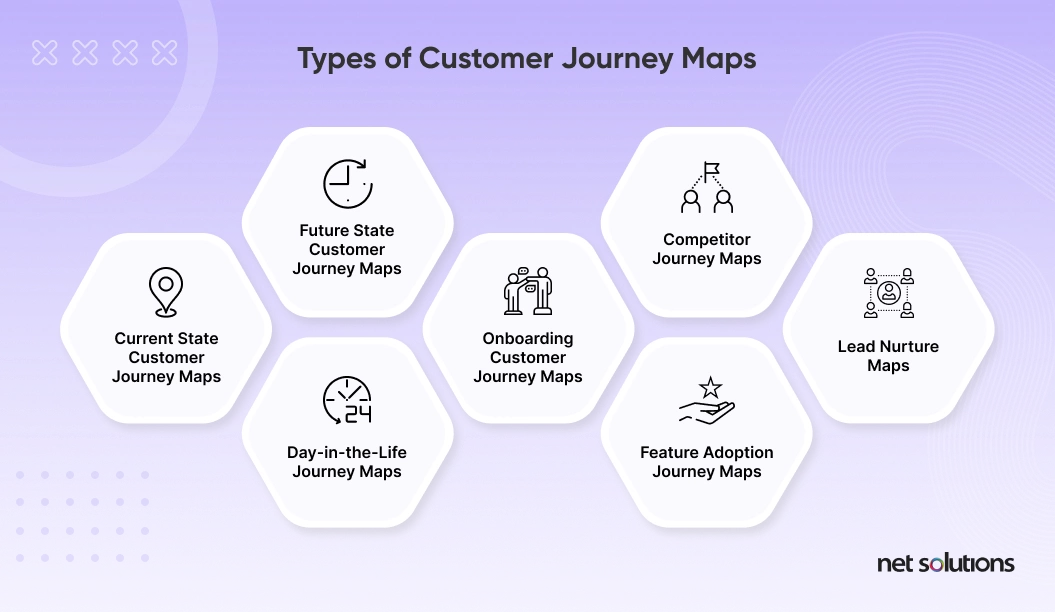Summary: Understanding customers’ journey from their perspectives is crucial for building great products, and there’s no way to do that besides customer journey maps. Read on to learn how to build a customer journey map. Also, find the ready-to-use templates from our product development experts for better understanding.
Creating “sticky”, market-dominating software products begins with understanding your target audience and building a customer experience that caters to their needs. Before your UX designers build a single wireframe and before your developers write that first line of code, you need to understand the journey your customers take when they interact with your brand and purchase products like the ones you’re working to create. In simple words, you need to create a customer journey map.
What leads them to seek out a solution similar to yours? What inspires them to explore your product and all it has to offer? What makes them click that “purchase” button and keep coming back? One way to answer these questions is to create customer journey maps. This post will tell you how to create customer journey maps, and it includes eight templates for different types of maps.
What is a Customer Journey Map?
A customer journey map is a visual representation of the path a customer takes as they interact with your brand and its products. Customer journey mapping enables everyone involved in product development and marketing to gain a clear understanding of a typical customer’s needs, drives, and frustrations, along with those make-or-break moments that can either turn them into loyal customers—or turn them off from your brand for good.
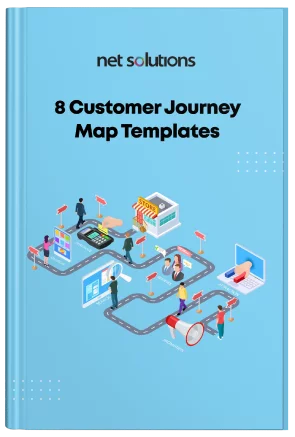
We respect your privacy. Your information is safe.
What is Customer Journey Mapping?
Customer journey mapping is an integral part of experience design. It involves a concerted, systematic effort to visually represent the touchpoints that make up the buyer’s journey. By mapping out the entire customer journey, organizations can identify gaps and pain points, leading to improved user experiences that delight prospects, convert them into paying customers, and keep them returning for more.
Components of a Customer Journey Map
There are a number of different ways to approach customer journey mapping, and below you’ll see some of the different angles you can take. That said, all customer journey maps have certain things in common. They typically include an outline of the purchasing process, actions users take, emotions they experience along the way, pain points they face, and potential solutions available to them.
Of course, no company can create an accurate customer journey map based on their own assumptions about what the customer experiences. The best customer journey maps are based on customer feedback. Your customers will give you insights into their experiences that will undoubtedly surprise you, and their stories will completely reshape your theoretical understanding of how they experience your products and your brand.
1. The Buying Process
Customer journey maps begin with a list of key touchpoints in the buying process, often starting with the moment a customer becomes aware that they have a problem that requires a solution—known as the “awareness” stage of the sales funnel. It’s important to note that the awareness phase doesn’t describe the moment your clients become aware that your product exists. “Awareness” refers to the moment they realize they’ve got a problem in the first place—an issue your product could potentially solve if they knew about it.
Outlining the buying process starts with writing down those key touchpoints. This begins with the awareness phase and takes the customer through the process of discovering your product, evaluating their options, facing obstacles, creating an account (and often signing up for a free trial), making a purchase, and recommending you to friends, family, and colleagues.
2. Emotions Experienced, Pain Points, and Possible Solutions
What do your customers feel at every stage of the buying process? They might go from confused, to intrigued, to excited, to frustrated in a 20-minute period. By digging into their experiences and emotions at each touchpoint, you’ll get a clear understanding of what you need to improve to create a smoother, higher-converting customer journey.
Benefits of Customer Journey Mapping
Customer journey mapping takes time and effort, but the practice offers a number of benefits, both on a granular level (when it comes to designing product features) and on a broader, strategic level (in terms of how you position your brand).
If you take the time to create detailed, well-researched customer journey maps, they will help you:
- Understand your target audiences
- Improve customer retention/reduce churn
- Build a customer-centric organization where each department is focused on successful acquisition and enduring satisfaction
- Align your brand positioning with your target market’s needs, drives, and expectations
5 Steps to Creating a Customer Journey Map
We’ve said it before and we’ll say it again—customer journey maps are rooted in solid data about the tangible customer experience. And while there’s a fair bit of creativity involved, the best customer journey maps arise from a systematic approach to understanding the customer journey. The following seven steps will help you create a useful customer journey map that leads to better products, more intelligent marketing, and repeat business.
Step 1: Identify Your Goals
What are you trying to measure with this particular customer journey map? Are you interested in a specific set of steps that one type of customer has to take in order to complete a purchase? Are you looking, instead, to determine how a broader segment of customers evaluate all the options available in the marketplace? Do you have another goal in mind?
The first step toward creating a customer journey map requires you to identify:
- Market segments to focus on
- Specific products and purchases to evaluate
- The scope of your customer journey map (see below for some of the different types of journey maps available to you)
Step 2: Identify Your Target User Personas
User personas are semi-fictional representations of your ideal customers, but you won’t pull them from thin air. User personas are based on actual customer data, and they help you empathize with the challenges your customers face, the emotions they experience as they interact with your brand and the many ways you can help them achieve their goals.
You may find yourself creating different customer journey maps for different personas, since the way each group of users experiences your brand will differ—as will the challenges they face and the goals they’re attempting to achieve.
Step 3: List Every Touchpoint
Now it’s time to dive in and list every step in the customer journey, which ultimately consists of a series of touchpoints where a customer interacts with your brand.
How do you identify these touchpoints? First, you’ll want to take the customer journey yourself. See what it’s like to search for the solution you offer, enter your sales funnel, review the options available, and complete a purchase.
Next, you’ll gather feedback from customers within your target audience and determine how they experience your brand. What does their customer journey look like? What frustrations do they experience, what emotions do they feel, and what pushes them toward conversion?
Step 4: Create a Detailed Customer Journey Map
As we mentioned earlier, customer journey maps come in many forms. However, they typically feature vertical columns that identify the different phases of the customer journey on a timeline, running from left to right.
A simple customer journey map might look like the following example. This fictional journey map takes a specific user persona through the different stages of the sales funnel, identifying touchpoints, emotions, pain points, and internal dialogue along the way. The different stages of the customer journey map explore the process for a busy, urban executive who decides to use a meal prep service that specializes in the healthy, tasty meal delivery.
Notice how different touchpoints highlight this fictional company’s wins, while other touchpoints bring up clear areas for improvement. By fixing the hiccups in the buyer’s journey and doubling down on what works, the company can increase conversions, upsell existing customers on larger packages, and increase its market share.
Step 5: Evangelize the Customer Journey Map
Once you’ve nailed down your customer journey map, it’s time to share it throughout the company. Every department will benefit from having some understanding of the customer journey, but it’s particularly important for the Marketing teams and the Product Development/Design teams to understand and internalize the customer journey. The more intimately you understand your customers’ struggles, the better you’re able to design an experience that boosts your bottom line.
Rethinking and Revising Your Customer Journey Maps
Customer journey maps are not set in stone. These are living, breathing documents that will change as you:
- Get to know your target audience better
- Release new versions of existing products
- Introduce new products to the market
- Watch the landscape shift with new competitors and new alternatives in the marketplace
You might also discover that your target audience shifts, or that you’re unable to successfully serve certain user personas without neglecting others. Mapping the customer journey will help you make smart, strategic choices.
Different Types of Customer Journey Maps
Customer journey maps come in many different forms. The most basic customer journey map you’ll find is the “current state” journey map (see the example above). This type of journey map shows how a customer travels through your sales funnel and how they interact with your current brand—although they can be far more detailed than the example we provided above.
Other types of customer journey maps include:
- Current State Customer Journey Maps: This map outline the existing customer journey, highlighting the emotions, thoughts, and actions that customers experience at key touchpoints.
- Future State Customer Journey Maps: It outlines a hypothetical journey your customers might take if you decided to implement new features or design new products.
- Day-in-the-Life Journey Maps: These customer journey maps explore the everyday experience of a hypothetical customer, exploring how they interact with your brand (or similar solutions) from the moment they wake up to the time their head hits the pillow at the end of the day. This sort of journey map is common for the products and brands we interact with daily (e.g., cell phones, social media platforms, email software).
- Onboarding Customer Journey Maps: Onboarding maps specifically focus on the journey new customers take, highlighting their drives, emotions, and frustrations as they learn to use your product for the first time.
- Feature Adoption Journey Maps: Each time you implement new features, customers have to decide how they want to engage those features. Feature adoption journey maps help you explore that process.
- Competitor Journey Maps: As the name implies, these journey maps explore a competitor’s customer journeys. This will help you better strategize your own customer journey, avoiding problems your competitors face and mirroring their successes
- Lead Nurture Maps: This common B2B customer journey map is often used for long sales cycles. These maps explore the many touchpoints a prospect experiences as you nurture leads and create customers

We respect your privacy. Your information is safe.
Reaping the Rewards and Forging Ahead
Once you’ve put in the work to create a series of customer journey maps that help you understand your target audiences, it’s absolutely vital to circulate this information throughout your company. Keep the customer journey, along with their drives and pain points, top of mind at every level of the organization. Yes, this means going beyond Product Design, Development, and Marketing.
Does Customer Support staff truly understand what it means to answer a customer’s questions and put their mind at ease? Does your Sales team truly empathize with your customers’ pain points? Are the C-Suite executives committed to building a customer-centric organization, steering the entire business toward your customers’ needs?
A solid set of customer journey maps will only prove valuable if the entire organization is aligned. Once you’re all on the same page, you’ll clear the path to acquire customers who not only keep coming back—they evangelize your brand to their friends, family, and colleagues. Companies that evoke this kind of response in their customers are bound for success.
Frequently Asked Questions (FAQs)
1. Why do you need a customer journey map?
The path a customer takes to purchase your products and engage your brand is often different than you might imagine. You’re very close to your products, and you’re probably picturing a more linear purchasing process than what actually occurs. Creating a customer journey map will help you understand customer pain points and those optimized touchpoints that cause the most friction.
2. How does customer journey mapping enable omnichannel marketing?
Customers discover businesses in a variety of ways—word of mouth, Google searches, and traditional advertising (e.g., TV, billboards). Until you study the customer journey, it’s impossible to optimize your omnichannel marketing approach.
3. How does a customer journey map improve the customer experience?
Customer journey mapping allows product and marketing teams (along with everyone else in an organization) to better empathize with customers. Product teams can create workflows that optimize the buying experience, and marketing teams can design inbound campaigns that reduce friction and win more conversions.
Great digital products are fueled by an in-depth understanding of your customers’ journey.
Talk to our experts to build the right product with the right customer journey map.


 Updated: May 20, 2022
Updated: May 20, 2022
